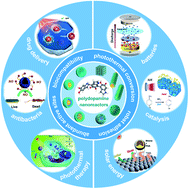Polydopamine-based nanoreactors: synthesis and applications in bioscience and energy materials
Abstract
Polydopamine (PDA)-based nanoreactors have shown exceptional promise as multifunctional materials due to their nanoscale dimensions and sub-microliter volumes for reactions of different systems. Biocompatibility, abundance of active sites, and excellent photothermal conversion have facilitated their extensive use in bioscience and energy storage/conversion. This minireview summarizes recent advances in PDA-based nanoreactors, as applied to the abovementioned fields. We first highlight the design and synthesis of functional PDA-based nanoreactors with structural and compositional diversity. Special emphasis in bioscience has been given to drug/protein delivery, photothermal therapy, and antibacterial properties, while for energy-related applications, the focus is on electrochemical energy storage, catalysis, and solar energy harvesting. In addition, perspectives on pressing challenges and future research opportunities regarding PDA-based nanoreactors are discussed.



 Please wait while we load your content...
Please wait while we load your content...